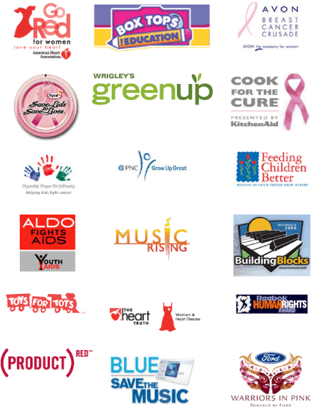Building on our new understanding of what cause marketing is (a partnership between a nonprofit and a for-profit for mutual profit) and how we can use it (point-of-sale, percentage-of-sale, licensing), cause marketing expert Joe Waters schools us in the tactics for running a successful cause marketing campaign, beginning with an important caveat: You’re not going to get rich off of cause marketing, so know why you’re using it and where it will get you.

In part II of our Cause Marketing series Joe helps us determine when cause marketing is right for your company, how to go about it and what to expect from your non-profit partner. Joe is the Director of Cause and Event Marketing at Boston Medical Center and blogger at Selfish Giving,
Listen to our conversation (30 minutes). As usual, I’ve highlighted some points below.
To download instead, right-click and save.
- Cause marketing won’t make you rich (be you a non-profit or for-profit). Non-profits raise only 5-15% of funds from corporations and marketing makes up a portion of this pot. Businesses can expect a similar ratio. Marketing is one element of a successful business. The most lauded and tweeted campaign can’t save a lousy product, high prices or limited distribution long-term.
- Cause marketing is a potent part of the marketing mix. It’s not the only marketing tactic, but it’s an important one that businesses should focus on.
- A company’s best asset in cause marketing is authenticity and sincerity, not money or Angelina Jolie. If you are passionate and genuinely interested in an issue or non-profit, your actions to weave this passion into a marketing program will be appreciated (or viewed neutrally) rather than incur skepticism. Consumers are hard to fool.
- Choose a non-profit partner based on issue and scale. If you want less people to be hungry, pick that as your issue and then look for a hunger-oriented non-profit organization with good credentials that reflects the size of your company. National bigwig Feeding America requires a minimum annual donation of $150,000 from corporate partners, for example. Instead, research regional or local hunger organizations that would be eager to work with you. (Start with Idealist.org, Charity Navigator or GuideStar.) Together, your cause marketing program can raise the profile of the non-profit, turning them into a stronger and more appreciative partner and allowing your business to make a deeper impact.
- Be flexible and patient when dealing with non-profits. Repeat. In addition to winning over the executive director, the board of directors also needs to approve the partnership. This takes time.
- Expect to be transparent. Approach to the non-profit prepared to talk about how the program will work and how their organization and goals will be served. Expect to be financially transparent as well as non-profits have different disclosure and reporting guidelines.
- Offer more than money. Money is the easy commodity to give away. Although non-financial assets may take more thought, they bind your company to the non-profit and/or to consumers. A philanthropic organization can go to any number of companies for money, but your company offers them (and sometimes your customers) another asset. The Applebee’s restaurant group opened the doors to 72 Applebee’s restaurants in North Carolina, Arkansas and Oklahoma to non-profit groups on weekend mornings, allowing them to host pancake breakfast fundraisers. Applebee’s didn’t loose paying customers as they were usually closed at this hour. Instead, they served their local communities and bound themselves to customers.
- Be ready to executive a large part of the program. As a business, you are bringing more than funds (and now non-financial assets) to the table. Particularly if the non-profit you are working with is small or new at these types of programs, you’ll have to carry a good portion of the program. Like you, non-profits have limited resources and staff. It’s important to set the expectations from the start, have an understanding of how the work will be divided and…be ready to work.
- The balance changes if the non-profit approaches you. Then, the onus is on them to make the program a success.
- A stand-alone retail store can still execute cause marketing programs, including pinups or point-of-sale. A pinup campaign is about engaging the customer with the cause while they are checking out. Pinups raise awareness as well as money and both should be valued.
- Vagueness is a death knell in cause marketing. Customers expect to know how much of their purchase or your profit is going to which non-profit and when. Don’t leave out the details. It reeks of falsity.
- Should companies implement cause marketing programs for Haiti? Joe has a fantastic! piece on how businesses should contribute to Haiti relief. I wrote about an offensive cause marketing campaign here and concluded that a flat grant was the right thing to do. Joe elaborates, advising a donation upfront and non-financial assets (see # 7). Only then could you look at a very careful marketing program.
Next time we’ll talk about measuring your campaign’s success and utilizing social media. Was this interview helpful? Why don’t you tell Joe what you think of the interview on Twitter.





 I'm Olivia Khalili. I created Cause Capitalism to show you how to grow your business by incorporating a social mission.
I'm Olivia Khalili. I created Cause Capitalism to show you how to grow your business by incorporating a social mission. 

Its excellent as your other content material : D, appreciate it for posting .
Thanks, Beatrice. Joe’s such a fantastic resource. It was fun to do this series together.